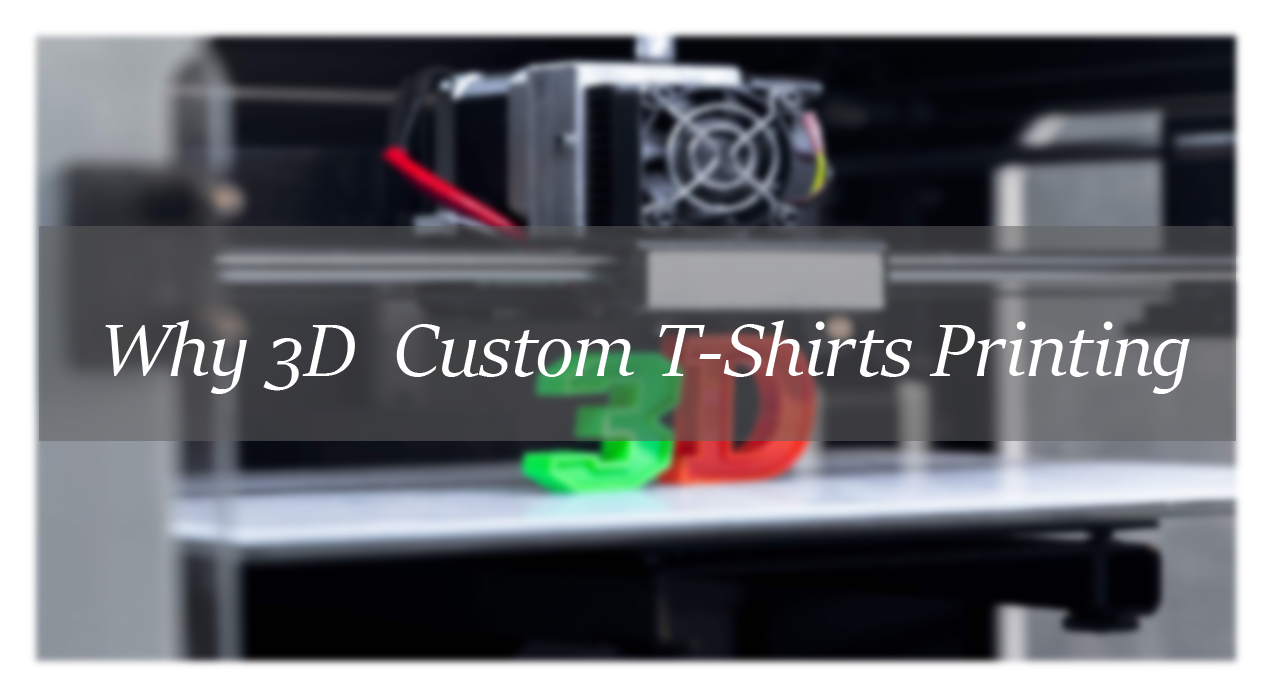

Why 3D Custom T-Shirts Printing?
3D printing on custom T-shirts can be used to create unique and personalized designs that cannot be achieved through traditional printing methods. Therefore, this technology allows for intricate details, textures, and raised elements to be incorporated into the design, giving the shirt a truly custom look. Additionally, 3D printing can be used to produce small quantities of shirts, making it ideal for individuals or small businesses that want to create one-of-a-kind products. This article explains the top benefits of 3d printing for small businesses and how it is helpful for the fashion industry.
What is 3D Printing on T-Shirts?


3D printing on t-shirts is a method of printing that creates a three-dimensional design on a t-shirt. This process uses specialized 3D printers to print a design in layers of material, creating a raised and textured effect that can add depth and dimension to a t-shirt design.
Unlike traditional printing methods, 3D printing on t-shirts allows for a greater design. It allows freedom and the ability to create intricate, detailed designs that would be difficult or impossible to produce using other methods. The end result is a truly custom and unique t-shirt that stands out from the rest.
Benefits of 3D Printing for Small Businesses:
There are several benefits of using 3D printing in custom manufacturing, including:
Speed and Efficiency: 3D printing can significantly speed up the manufacturing process. It allows for faster turnaround times and reduced lead times.
Customization: 3D printing enables manufacturers to produce highly customized products. It also allows them to meet the specific needs and preferences of individual customers.
Cost Savings: 3D printing eliminates the need for expensive tooling and molds. It can reduce upfront costs and increase the cost-effectiveness of custom manufacturing.
Design Freedom: 3D printing provides greater design freedom. Which enables manufacturers to create complex and intricate shapes. That would be difficult or impossible to produce through traditional manufacturing methods.
Small-Batch Production: 3D printing enables manufacturers to produce small batches of custom products. It can reduce waste and make it easier to test and iterate on designs.
Sustainability: 3D printing reduces material waste and minimizes the carbon footprint associated with transportation. It makes it a more sustainable option for custom manufacturing.
Quick Prototyping: 3D printing enables small businesses to quickly and easily produce prototypes. It can also enable the testing of new designs, and making changes in real time. This can accelerate product development and help small businesses get new products to market faster.
Increased Agility: 3D printing can make it easier for small businesses. Increased agility can quickly pivot and respond to changes in the market. Hence, it can rapidly produce new products and prototypes without the need for expensive tooling and molds.
Top Ways to Dye your T-Shirt in 3D Printing:
Here are a few popular methods for dying 3D-printed t-shirts:
Dye Sublimation: This method uses heat to transfer dye onto the fabric. This can create a vibrant and long-lasting print that won’t crack or fade.
Direct-to-Garment Printing: This method uses specialized inkjet printers to directly print the design onto the fabric of the t-shirt. DTG printing is versatile and can produce high-quality prints in full color.
Screen Printing: This method involves creating a stencil of the design. This technique using it to apply the dye to the fabric. Screen printing is a cost-effective option for producing high-quality prints in large quantities.
Heat Transfer: This method involves printing the design onto a special transfer paper, which is then applied to the t-shirt using heat and pressure. This method is quick and easy, but may not be as durable as other methods.
These are a few of the most popular methods for dying 3D-printed t-shirts. The best method for a particular project will depend on the design, the intended use of the t-shirt, and the production quantity.
Easy Steps and Your 3-D T-shirt is Ready!
Here is a simplified guide to 3D printing a t-shirt:
Design: Create a design using 3D modeling software or select a pre-made design from a marketplace. Ensure the design meets the specifications of the 3D printer being used.
Printing: Load the design into the 3D printer and start the printing process. Depending on the complexity of the design and the size of the print, this can take several hours or several days.
Removal: Once the print is complete, remove it from the printer and carefully remove any support structures.
Dyeing: Select a dyeing method, such as dye sublimation, direct-to-garment printing, screen printing, or heat transfer. Follow the instructions for the chosen method to apply the dye to the 3D-printed design.
Finishing: Once the dye is applied, allow the t-shirt to dry and then inspect it for any defects or issues. Make any necessary corrections and then the t-shirt is ready to wear.
These are the basic steps involved in 3D printing a t-shirt. Depending on the specifics of the project, additional steps or equipment may be required, such as post-processing, sanding, or gluing.
Future of 3D Printing in Custom Clothing or in the Fashion Industry?
The future of 3D printing in the fashion and custom clothing industries is promising. Here are a few trends and potential future developments:
Increased Customization: 3-dimensional printing technology is constantly improving, and it’s likely that in the future, consumers will be able to design and print their own custom clothing with greater ease and precision.
More Sustainable Production: It can reduce waste and minimize the carbon footprint associated with transportation, making it a more sustainable option for the fashion industry.
Greater Design Freedom: This enables designers to create complex and intricate designs that would be difficult or impossible to produce using traditional methods. This opens up new possibilities for innovation and creativity in the fashion industry.
Reduced Time-to-Market: With 3D printing, it’s possible to produce prototypes and small batches of products quickly, without the need for expensive tooling and molds. This can help designers and brands get new products to market faster.
Expansion into New Materials: Currently, most 3D printing in the fashion industry is done using plastics and other synthetic materials. However, there is potential for 3D printing with natural materials such as wool, silk, and cellulose in the future.
Overall, 3D printing has the potential to revolutionize the fashion industry by enabling greater customization, sustainability, and design freedom. As technology continues to advance, it’s likely that we will see more and more innovative applications in the years to come.

